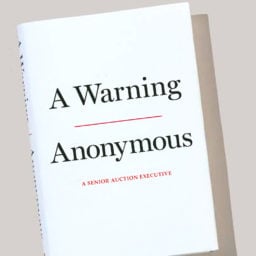On the first day back to school last week, I had lunch with dealer Harry Blain at Sant Ambroeus on Madison Avenue, New York’s uptown art canteen—just my luck I move to LUES (Lower Upper East Side) when the art world is in the midst of a shift to Tribeca. Within minutes I bumped into the Nahmad and Acquavella families dining at separate tables. Near the end of our meal, as Harry and I were talking shop, I noticed the notorious Aaron Richard Golub, lawyer to the Nahmads and George Condo, being led to a table with his young son in tow. As they wended their way towards our perch I furtively tried to waive the maître d’ away, but it was too late.
You see, I have a bit of a history with Golub, dating from when he once cursed me out at the top of his lungs in Simon Lee’s Art Basel Miami Beach booth. The animus relates to the fact Golub had introduced me gratis to Simon Lee, who I did business with (and curated a show for) over the years, while I asked dealer Rod Steinkamp for a commission fee when he and Richard co-invested in some Chinese art after I acquainted them.

Kenny’s LUES (Lower Upper East Side) living space, decorated in his wife’s absence. Photo courtesy of Kenny Schachter.
This week, as Yogi Berra aptly put it, it was déjà vu all over again. When Golub spotted me at Sant Ambroeus, he made his way to our table and told Harry (who doesn’t even know him), “I’d talk to you but you are seated next to that asshole. That’s right, he is a real fucking asshole.” Which may be partly true, but is the bustling room of a restaurant the best place to convey such sentiments at full volume? He didn’t stop there. When I mentioned the fact that he might benefit from some anger management—as I had helpfully pointed out in Miami, too—steam practically erupted from the enraged 76-year-old attorney’s flared nostrils, who shouted, in front of his bewildered child, that we should step outside for a fight. (I’m a writer not a fighter.) If ever there was a signal that the art season was officially underway, that was it.
My very public altercation with Richard reminded me of a trend in art economics, where an old guard—white, male, and, occasionally, ahem, problematic (just watch Golub’s absurd, funny-by-default music video “Dancing for Justice”)—is fast becoming outmoded, and starting to look a bit ridiculous. When it comes to lawyers, this is happening at Sant Ambroeus. When it comes to artists, this is happening on the secondary market.
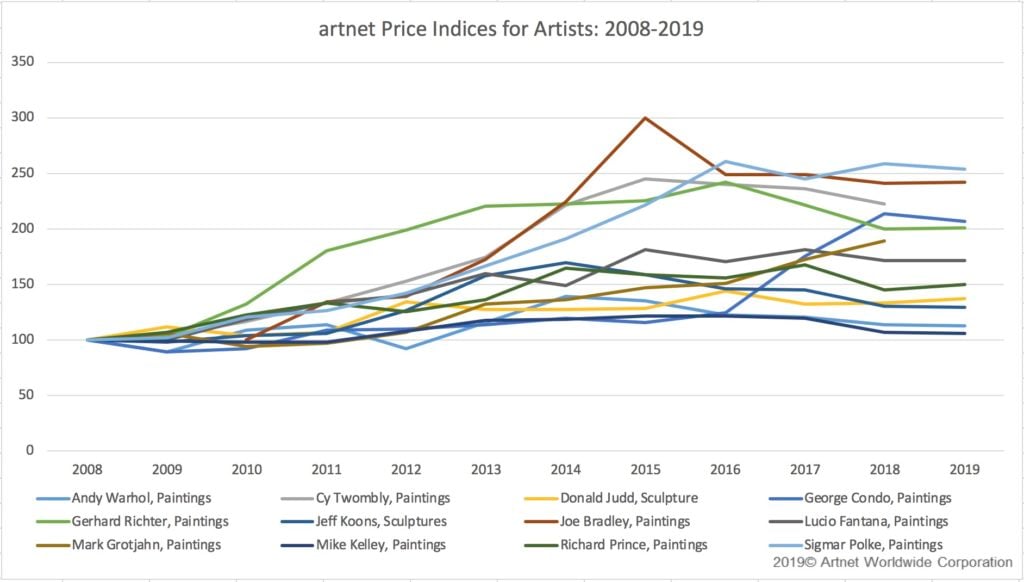
Notice a trend in these auction results? Graph courtesy of the artnet Price Database.
Classic contemporary stalwarts of the latest boom, which seem to have lasted forever (and a day or two) have flatlined, including Andy Warhol, Gerhard Richter, Sigmar Polke, Cy Twombly, Jeff Koons, Rudolf Stingel, Christopher Wool, Mike Kelley, Donald Judd, George Condo, Lucio Fontana, Richard Prince, and Mark Grotjahn. This in no way refers to the burgeoning primary market of all the above, who are still firmly with us—except for Koons, whose pornographically priced, lawsuit-attracting baubles have slowed on that market too. One friend is being asked to resell Condos that his clients only just bought, and they are auctioning at prices approaching 20 to 40 percent less.
A similar situation has befallen the classic car market, as Bloomberg reports in an article whose headline copy could just as easily apply to today’s art market: ‘The Classic-Car Feeding Frenzy Is Over for Skittish Collectors – Years of growth have left market over-saturated and pricey – Lower-cost cars are booming as younger collectors pile in.” In art, this translates to lower-priced works by woman and artists of color soaring at auction as the art world plays catchup for past marginalization—while causing some anxiety by spec-u-lectors up to their eyeballs in trophies by previously lionized Caucasian male artists.

A photo-collage portrait of Richard Prince by Kenny Schachter from “Summer Rental” at Rental Gallery, on view through September. Courtesy of Kenny Schachter.
If there was any more obvious a sign of froth, the age-old sign of a top just as surely in a market as a mug of beer, you can turn to the flamboyant gallery expansions by the likes of Gagosian, Pace, Zwirner, and Hauser & Wirth as they encroach more and more of Manhattan’s (and the world’s) choicest real estate with imperially scaled galleries. You can also see it in the about-to-be-effectuated privatization of Sotheby’s. In all of this tumult, with news traveling at ever-accelerated speeds, the up and down cycles of artists’ price fluctuations are shorter than at any time previously. From waiting-list-hot to impossible-to-offload toxicity, artists are being churned, burned, and spurned as never before.
When you look at previous auction stars, there are fewer works on offer because people stop selling when they realize stellar prices no longer exist the way they used to. For the first in a long while, we’ve seen the market for high-flyers behaving in lockstep, whereas normally there would be individual artists moving up as others trended down. The counterargument is that the slack has been picked up by the previously mentioned women and black artists heading skyward—but, then again, as a word of caution, Sam Gilliam and Mark Bradford are both falling back along with Stingel, etc., after stratospheric rises. There are exceptions to this rule, often courtesy of the Saudi ruling family, which has become among the most active buyers propping up the likes of Condo and Prince, and even paying a fortune to access Gerhard Richter’s studio. Funny how the art world turns a blind eye to the regime that made sushi of Washington Post journalist Jamal Khashoggi. (Hope I’m not next.)
All of this relentless price pressure will surely effect small and mid-level dealers who are continuing to fall prey to poachers and, worse, facing lawsuits for nonpayment to artists. This is now said to be the situation with Michele Maccarone, once a Midas of the mid-tier who didn’t respond to queries about potential legal actions that might soon be initiated by Ryan Sullivan (who had no comment) and Nate Lowman (who has yet to respond at the time of this writing). Another sign of the hard times that abound for many (other than the biggies… for now, anyway)? I bumped into an artist and complimented her on the work I purchased a year and half ago, which took her by surprise—she was neither aware of that fact nor paid. A convenient oversight by her struggling but well-regarded gallerist.
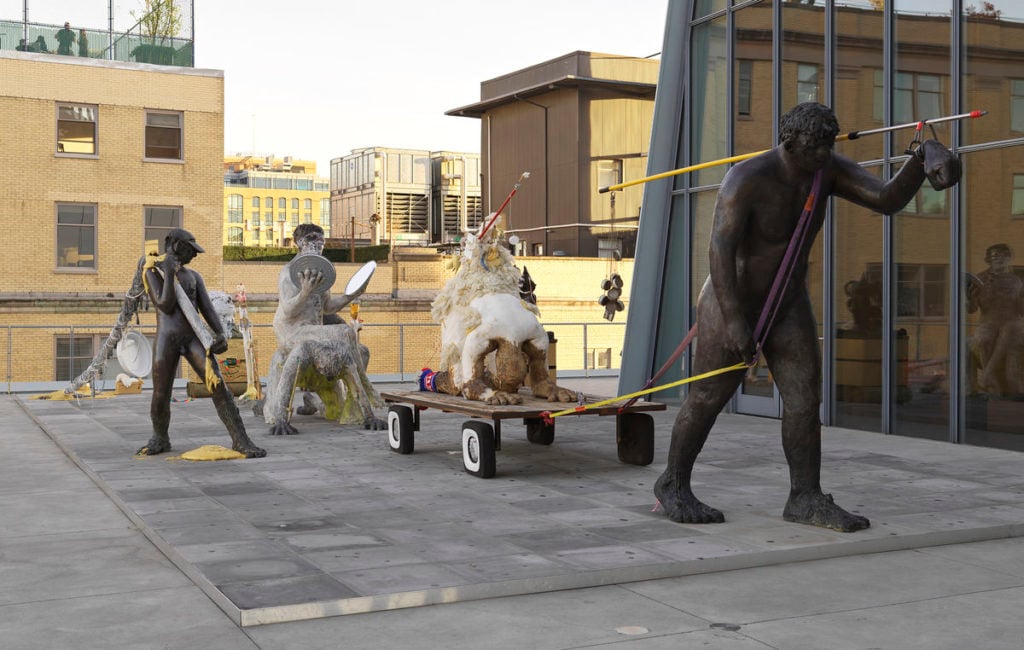
Nicole Eisenman’s Procession (2019) in the Whitney Biennial. Courtesy of the artist, Vielmetter Los Angeles, and Anton Kern Gallery, New York. Photograph by Object Studies.
Nicole Eisenman has departed Anton Kern, defecting to Hauser (that gallery seems to be swallowing the art world whole); and, as previously reported, Avery Singer has left Gavin Brown, but is still fence-sitting between Hauser and Zwirner (after ruling out Gagosian for other reasons). Flux also abounds in the still-mushrooming market for graffiti and street artists, or those influenced by them, such as Eddie Martinez, rumored to be heading to Gagosian from Mitchel-Innes & Nash, though they claimed not to have knowledge of the defection, while Gagosian never responded to queries. Eddie himself had this to say: “Nobody has told me this but people keep telling me they hear I’m doing shows at all these galleries that I don’t know about.” Hmm, I still wouldn’t discount it. JR is headed to Pace, which will inevitably impact on the extent of his commitment to Perrotin—there are only so many ginormous photos you can glue on a wall. Though maybe I’m mistaken on that front. In the small to mid-sector, Walter Price has bolted Karma for Greene Naftali.
Also part of the continually changing landscape, the London art scene is moribund for reasons too numerous to address here. (I got out in the nick of time.) It’s become a currency arbitrage to pay galleries by installments in pounds, with one gallery going as far as advertising that the pound is down to its lowest level since 2017, thereby presenting an unprecedented opportunity for dollar and euro buyers. Speaking of political instability, is Art Basel Hong Kong toast? I’m not going, at least. (I don’t need to be beat up twice.) If ever there was a more topsy-turvy time in the world—socially, politically, economically, and environmentally—I can’t remember it.
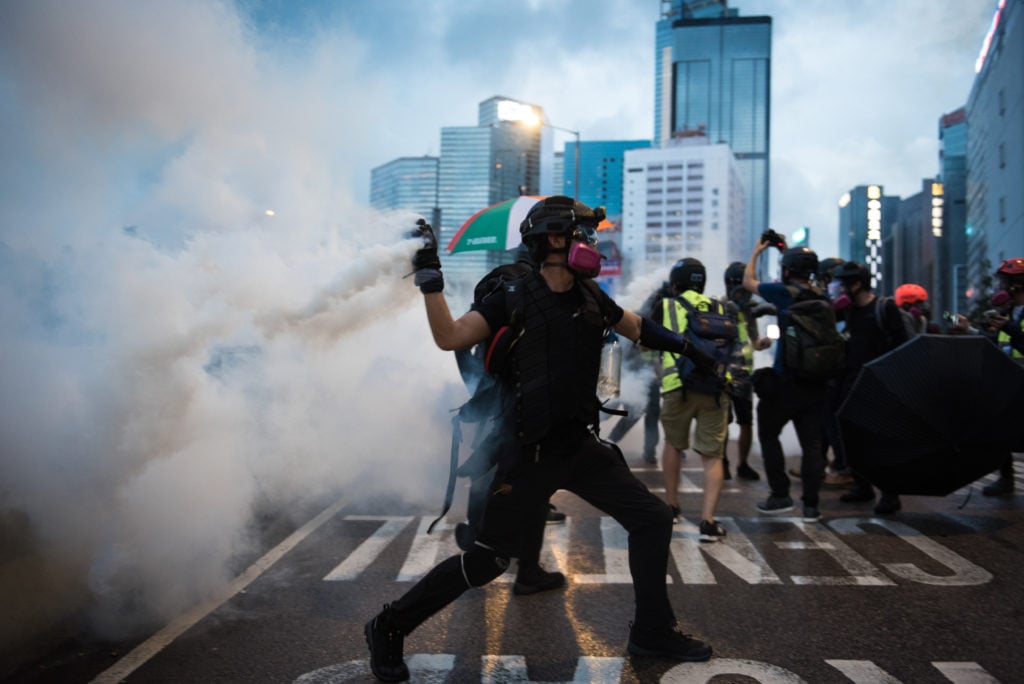
A protester in Hong Kong throws back a tear-gas round at police during an unauthorized demonstration on the fifth anniversary of the denial of universal suffrage to Hong Kongers by the Chinese state. (Photo by Aidan Marzo/SOPA Images/LightRocket via Getty Images)
Another factor fueling market mayhem and unbridled speculation is debt, one of the three Ds that traditionally bring art to market (divorce and death being the other two). The difference now is that debt is arising from leveraged art, which has become more of a force behind resales these days. With a trillion or so worth of art filling the plethora of freeports worldwide (and some actually hanging on walls), it has never been easier to borrow off the back of artworks—until, that is, the inevitable need to pay the piper (back) pops up.
Auction houses are like big pharma, profiting from feeding addicts with easy access to opioids, then making even more money when they become hooked (if they survive), providing a cure by way of additional costly meds. The art-world version the widespread availability of credit collateralizing art at fifty cents to the dollar, then swooping in to re-auction those works (and more) when investors can’t pay. This is an increasingly common trajectory now that art-lending spigots have flooded the market with ready cash, fueling art-flation. Watch for more such deaccessioning in the fall.
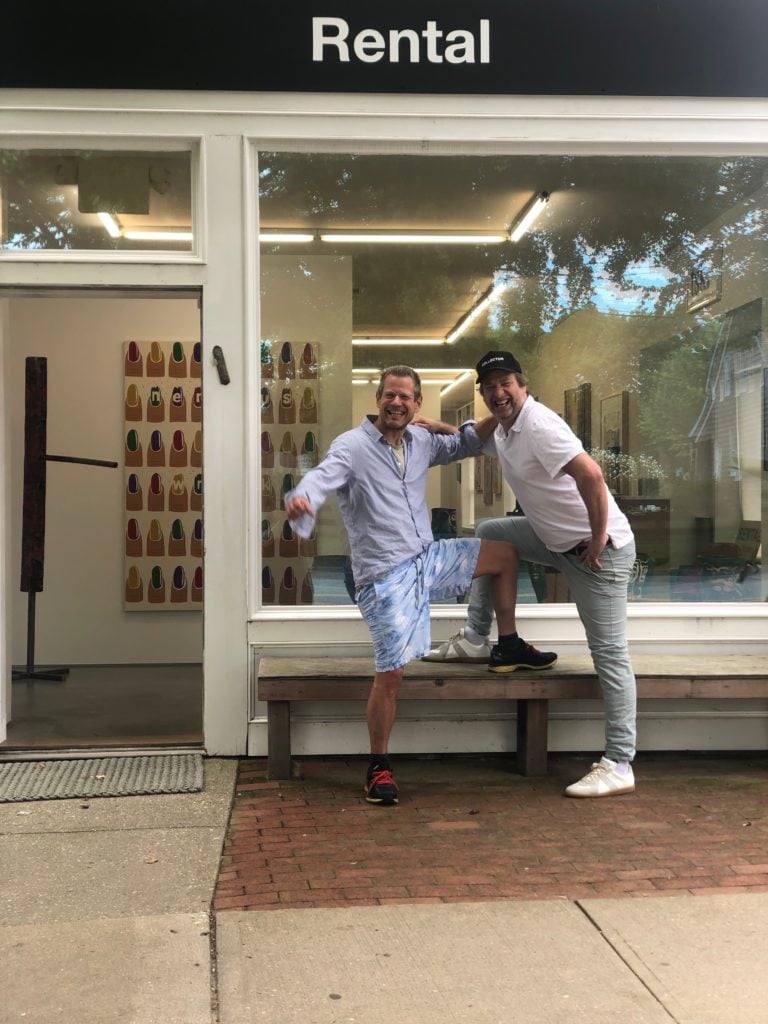
Kenny and Rental Gallery’s Joel Mesler: like a Catskills Vaudeville show, but worse. Photo courtesy of Kenny Schachter.
Things to look forward to in the nearer future? There is the Bridge car-and-mini-art fair on a golf course in Bridgehampton next week, starring my 1977 Volkswagen Golf, fittingly enough. And, the “Summer Rental” group show I curated at Joel Mesler’s Rental Gallery in East Hampton, featuring work by Mark Grotjahn (forget what I said before), Jacquline Humphries, Roy Lichtenstein, and Loie Hollowell, who is about to premier at Chelsea’s new Pace palace. Oh, the show also has work by Joel and various members of my family, and it’s up through September. (Consider this self-promotion, nepotism, and self-dealing all rolled into one. You’re welcome.) After that, it’s back on the hamster wheel en route to Frieze and FIAC—if I survive another encounter with Richard Golub, that is. Any of you guys moonlight as boxing coaches?
Oh, and this just in via direct message on Instagram:
“Kenny there is an Israeli guy in Barcelona looking to buy valuable assets in cash. Euros. Everything must be presented to him – provenance, valuation etc. He will pay travel fees plus a 50k fee if he agrees to buy and then changes his mind on the day. Would you be interested in selling some expensive pieces of art to him? I can arrange if so. Payment will be cash in euros. Or 150k in wire transfer or the full amount in cripto. It needs to be below market value from his point of view. Interested?”
For your information, I replied negatively. We have seemingly entered a period of post-art-dealing anarchy, where anything goes (other than buying art to hang in your home). How much more unhinged can things get? I fear we are about to find out.









